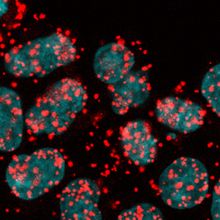Login
Subscribecancer

“Silent” Mutations Make Noise In Cancer
Katarina Zimmer | May 1, 2023 | 10+ min read
Synonymous mutations have long been ignored in cancer studies since they don’t affect the amino acid sequences of proteins. But research increasingly reveals that they can have disease-driving effects.

Infographic: How “Silent” Mutations Can Disrupt Protein-Making
Katarina Zimmer | May 1, 2023 | 3 min read
Although scientists often assume that synonymous mutations don’t cause any biological effects because they don’t alter the amino acid code, recent research shows that they can influence transcription and translation in a variety of ways.

Cell-Free DNA in Clinical Diagnostics
Tecan | 1 min read
Advancements in measuring DNA in bodily fluids create new opportunities for understanding disease.

Helping Engineered T Cells Find Their Way to Tumors
Nele Haelterman, PhD | Apr 18, 2023 | 3 min read
Susan Thomas discusses how her team engineered a microfluidic device to screen for T cells with improved homing capability to tumor cells.

Bacterial Tractor Beams Bring Radiation to Tumors
Rachael Moeller Gorman | Apr 17, 2023 | 3 min read
Colonizing tumors with engineered bacteria may allow researchers to target sites currently inaccessible to radionuclide therapy.

A Spotlight on Cancer Cell Metabolism
The Scientist’s Creative Services Team | 1 min read
In this webinar, Elena Piskounova and Christina Towers discuss the implications of metabolic changes in cancer cells for therapeutic development and efficacy.

Self-Charging Battery Battles Tumors in Mice
Natalia Mesa, PhD | Apr 4, 2023 | 3 min read
A battery that charges itself in salty fluids starves tumors of oxygen, helping improve some drugs treat cancer, a study finds.

Translation of “Jumping Genes” Creates Cancer Therapy Targets
Natalia Mesa, PhD | Mar 29, 2023 | 4 min read
Researchers find many tumor-specific antigens form when cancer genes and transposable elements link up.

Understanding How Single Cell Evolution Drives Tumor Complexity
The Scientist’s Creative Services Team | 1 min read
Andris Abramenkovs and Mark Lynch will discuss how to overcome challenges obtaining high-definition genomic data from single cells.

The Role of Adhesion Receptors in Cancer Cannibalism
Elina Kadriu | Mar 13, 2023 | 3 min read
Contact inhibition of locomotion by adhesion receptors prevents cancer cells from eating each other.

Molecular Biologist Michael Green Dies at 69
Lisa Winter | Mar 7, 2023 | 2 min read
Beyond his achievements in academia, he also cofounded three pharmaceutical companies and filed 15 patents related to cancer therapeutics.

The Genetics of Cancer Risk
Thermo Fisher Scientific | 1 min read
Learn how to discover cancer biomarkers with genomics.

Mutated Cohesin Throws DNA Splicing out of Whack, Resulting in Cancer
Shafaq Zia | Mar 3, 2023 | 2 min read
Cohesin mutations cause dysregulations in alternative splicing, contributing to tumor initiation and progression, a study finds.

Mutational Signature Indicates Risk of Kidney Cancer Recurrence
Holly Barker, PhD | Mar 1, 2023 | 2 min read
DNA sequencing can identify mutations that predict recurrence of renal cell carcinoma and may help low-risk patients avoid unnecessary treatment, a study finds.

How Gut Microbiomes Shape Anti-Tumor Immune Responses
The Scientist’s Creative Services Team | 1 min read
In this webinar, Andrew Y. Koh will discuss the role of the gut microbiome in modulating cancer immunotherapy.

Infographic: Transposable elements in cancer
Diana Kwon | Mar 1, 2023 | 1 min read
Jumping genes are let loose in cancerous cells, with multiple effects on cell health.

Long noncoding RNAs and Microproteins Can Spark Cancer—or Sometimes Squelch It
Rachael Moeller Gorman | Mar 1, 2023 | 10+ min read
Noncoding RNAs and microproteins, once considered genomic noise, are turning out to be critical to the progression of some types of cancer.

Neoantigen Prediction for Precision Immunotherapies
The Scientist’s Creative Services Team | 2 min read
Learn about the tools and resources researchers use to define, discover, and deploy anti-tumor immunotherapies.

Alex Muir Explores Cancer Cells’ Menu
Natalia Mesa, PhD | Mar 1, 2023 | 3 min read
The University of Chicago cell biologist is studying how the nutrients available to cancers influence their growth.

Jumping Genes’ Role in Cancer
Diana Kwon | Mar 1, 2023 | 8 min read
Transposons may be key players in how tumors develop and spread, but they also keep cancer at bay in some circumstances.